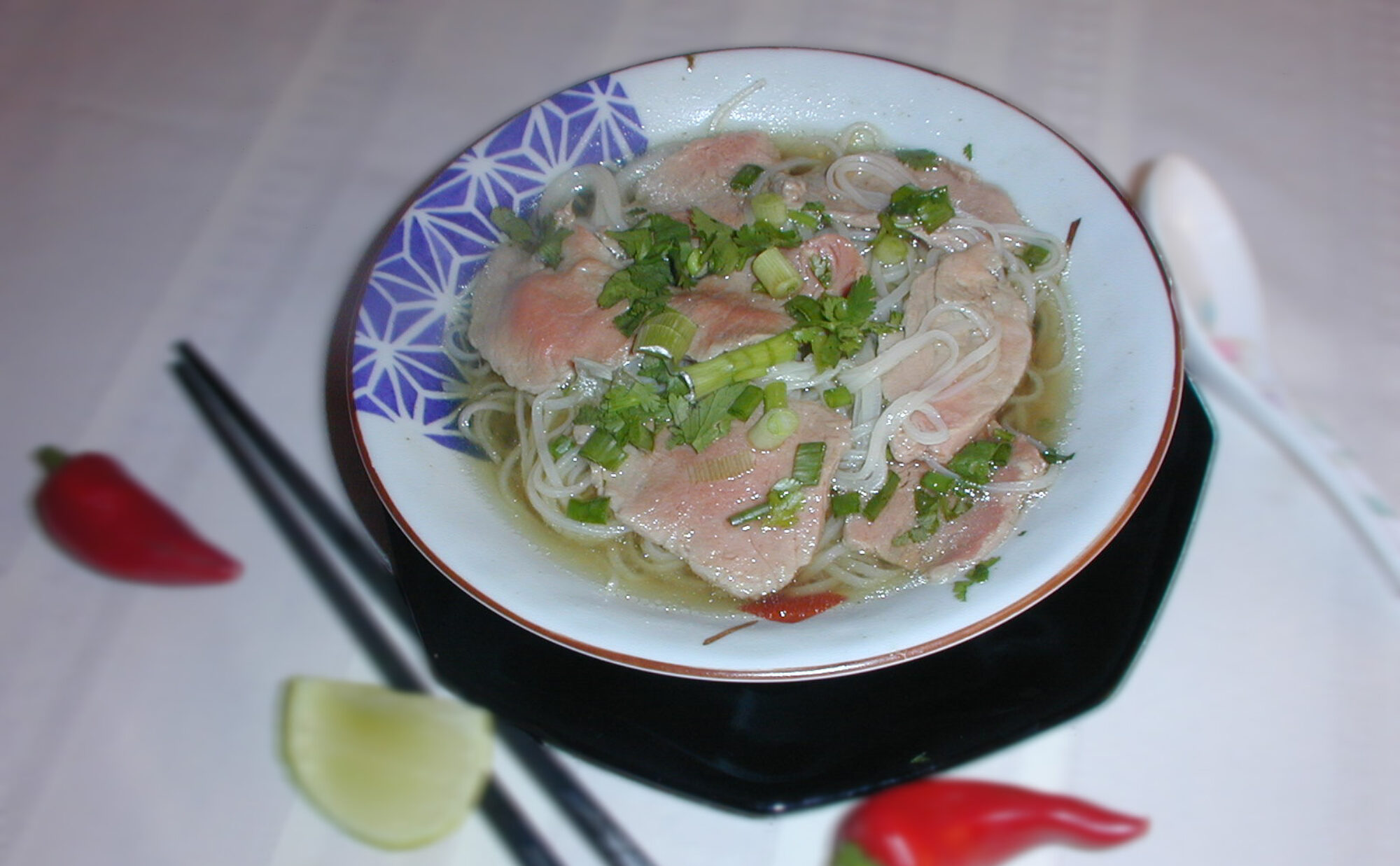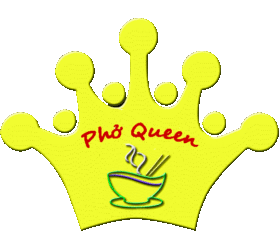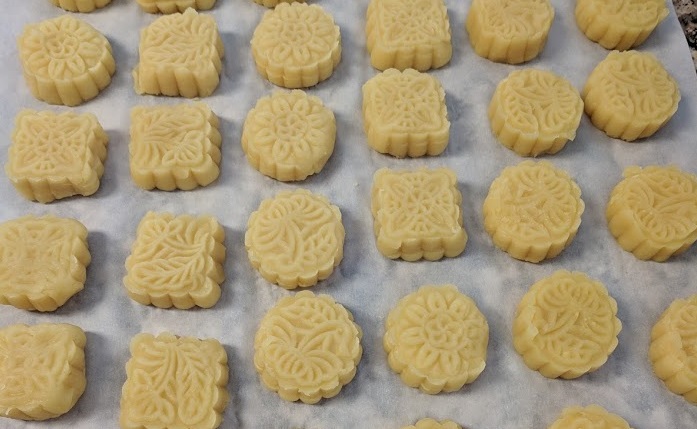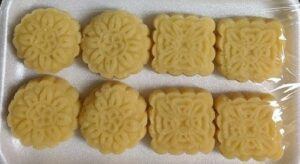 In this article, we will be showing how to make a Vietnamese Mung Bean Dessert called “Bánh Đậu Xanh”. They are available primarily during the Vietnamese holidays. “Bánh Đậu Xanh” is also known as mung bean cakes. You can find them in Asian stores during Tết New Year or Harvest Moon Celebration.
In this article, we will be showing how to make a Vietnamese Mung Bean Dessert called “Bánh Đậu Xanh”. They are available primarily during the Vietnamese holidays. “Bánh Đậu Xanh” is also known as mung bean cakes. You can find them in Asian stores during Tết New Year or Harvest Moon Celebration.
I extracted the recipe from a video on YouTube.com created by Văn Phi Thông. The video is in Vietnamese. I translated and converted the recipe content into English. The recipe is simple and the final product turns out delicious. The procedure is straight forward. The most difficult operation is cooking the beans. There are five main and 1 optional ingredients. They are gluten free and dairy free.
This recipe was created solely for my demonstrations. The Mung Beans Cakes turned out perfectly each time when I made them. I decided to make this recipe available online to share with others. I hope you find it useful and tasty.
As the owner of this website, I tracked down special deals for some products or services mentioned herein. As an Amazon Associate, I earn from qualifying purchases. When you use the link from this page to make a purchase, I may receive a small commission, and you may receive a great bargain – Full Disclosure.
Ingredients
- 2 cups (400 g) mung beans


- ¼ cup (100 g) coconut milk


- 2 cups (400 g) sugar
- 2 tablespoons (50 g) vegetable oil
- 1 teaspoon Salt
- (optional) 1 teaspoon vanilla or 1 vanilla powder packet
Clean the mung beans thoroughly until the water is nice and clear. Soak them for at least 4 to 5 hours or overnight. If you are in a hurry then use warm water to soak for 2 to 3 hours. Warm water speed up the soaking process. After soaked for the allotted time, clean the mung beans once again. Place the mung bean in a colander or a strainer and drain the water.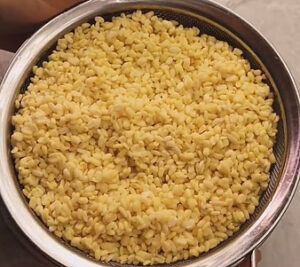
Cook the Beans
- Place the drained mung beans in a large pan. Add 1 teaspoon of salt. Add water until the water covers two to three inches over the mung beans. You can use the knuckle of your fingers as a measuring device, the water covers one to two knuckles would be sufficient. I often measure with my fingers. I think it is an Asian thing.
- Cook the mung beans using medium high heat. Cover until water boil. Keep cooking until the white foam covers the entire surface.
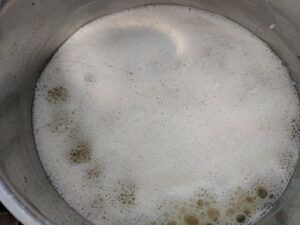 Then we pour out all the foam. Pour out most of the water and leave very little water left. How much is little? It is a judgment call on your part. We don’t want to see the water. The only time you would see the water is when you lean the pan over to one side. You could then see the water. The intention is for the mung beans to be cooked just right, not too dry then it’ll be flaky and not too wet then it’ll be mushy.
Then we pour out all the foam. Pour out most of the water and leave very little water left. How much is little? It is a judgment call on your part. We don’t want to see the water. The only time you would see the water is when you lean the pan over to one side. You could then see the water. The intention is for the mung beans to be cooked just right, not too dry then it’ll be flaky and not too wet then it’ll be mushy. - Cook under low heat with cover, if the heat level is from 0 – 10, use about 2. Cook for 12 – 15 minutes. After 12 minutes, open the cover and check to see if the mung beans are done. When the mung beans are very soft to touch then they are done. They should not clump together or be burnt at the bottom. We avoid too wet and mushy. This cooked mung beans are great fillings for many other Vietnamese cakes.
Process the Beans
Wait until the mung beans are completely cool before we put it into a blender. The hot temperature is not good for blender. It may blunt the blades. Split the mung beans into 2 to 3 batches to process the beans. We want the beans to be really fine so it will melt in your mouth with no clumpy texture.

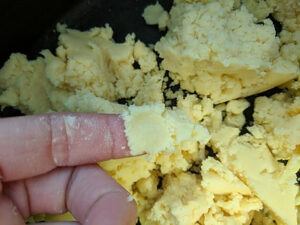
Frying the Beans
Once processed, put all the mung beans in a large frying pan. Add 2 cups sugar and ¼ cup coconut. Mix well while the pan is on medium high heat. The hardest is cooking the mung beans and achieving the balance so they are not dry or too wet. Bring mixture to boil then turn the heat down to medium. Taste the mung beans to see if they are sweet enough. Add sprinkle of salt to enhance the flavor of sweetness. Mix well.
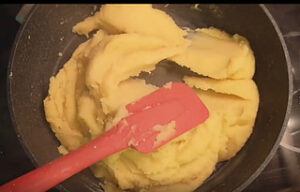
- Make sure the beans folded well together. They’ll become less sticky. If you feel the beans are too sweet you can add less sugar next time, perhaps 1-3/4 cups instead. Traditionally, the mung bean cakes are sweet. The sugar also acts as a preservative to keep the cakes last longer without refrigeration.
- Add oil once the mixture becomes dryer and less sticky. If prefer, you can add optional vanilla flavor – 1 packet or liquid vanilla. Mix well.
- The consistency will get heavier and harder to mix. You can form it into a large dough. Remove pan from heat.
Forming the Dough
- Pinch a piece from the dough and form it into 60 gram balls or to the size of your mold. Place the ball in the moon cake mold. Press and form the dough into shape. Do it quickly while the dough is still warm. We don’t want the dough to cool then it’ll be harder to form and become flaky.

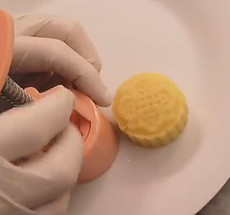


Conclusion
This batch should yield approximately 20 cakes varying to the size of your molds. Please Keep in mind, you can adjust the amount of sweetness of the cakes. Traditionally, the cakes are sweet. The recipe calls for 2 cups of sugar. You can use 50 grams or up to 1/2 cups less sugar if you prefer less sweet. If your mixture has less sugar, the cakes will not preserve as long at room temperature. Eat within one week or less. Otherwise, the mung bean flavor and fragrance will dissolve and leave behind an oily flavor and taste. Keep the mung beans refrigerated to keep them last longer.
The cakes serve well with hot tea. If there are any questions, please feel free to leave me a comment below. I would love to hear how the recipe works out for you. Enjoy!
